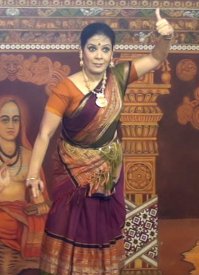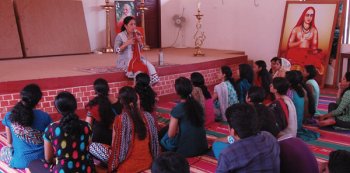
|   |

|   |
From Thought to Theatre: A movement workshop by Ramaa Bharadvaj - Nishith Anand November 7, 2013 On October 24, 2013 Bharatanatyam dancer/teacher Ramaa Bharadvaj (Director - Dance, of Chinmaya Naada Bindu Gurukul) took time off from her regular schedule to theatrically engage 60 MBA students of the Chinmaya Institute of Technology. Her workshop titled ‘From Thought to Theatre’ was presented by Chintech as part of its Students Empowerment Program and was held at the serene Adi Sankara Nilayam (the birth home of Adi Sankara), Veliyanad, Kochi. Prior to the workshop, on 23rd October, Ramaa presented her repertoire of three Bharatanatyam compositions: Mitranjali, Nandan's Dream and Sita Haranam.  Ramaa’s 4-hour experiential workshop endeavoured to enable the participants to communicate: how to vocalise, articulate, how to be heard, and make a point. She commenced by introducing the levels of communication: Angika (non-verbal/body language), Vachika (verbal), Aaharya (appearance) and Satvika (attitude). Demonstrating a few movements, she went on to elaborate the science behind dance. Physical movement is not muscle work, it is brain work. Brain creates movement through nerve impulses and sends it to the muscles; that's how the muscles move. Dance involves sequencing, patterning and variations, and thus the pre-frontal cortex (used for problem solving, planning and learning new things) takes over. Dancing, which involves breath awareness, emotional expression, mindfulness and intellectual engagement, encourages this more than any other tasks. Ramaa went on to explain the differences between right and left brained individuals, and how dance coordinates the two.  Using deceptively simple movements like swinging and spinning, the participants discovered the nuances of interpersonal coordination, space management and leadership. Ramaa followed this up with an introduction to STEMS (Space – Time – Energy – Movement - Shape) in everyday life as well as in theatre by encouraging the participants to create space patterns, appreciate rhythm, understand the sequencing of movements, creating energy and moods by bhavas and forming shapes using the body. She also effectively brought out the evocative symbolism of Indian thought (like right-left brain coordination of Namaste, the spiritual connotations of detatchment and beauty of the lotus flower, the cosmic significance of Vandanam in dance etc). The participants revelled at the novel concepts presented during the workshop, and discovered for themselves the significance of using their physical and psychic energies for effective communication. According to the feedback received from the participants, Ramaa’s dance recital was spellbinding and the workshop was truly experiential and one-of-its-kind. Nishith Anand, a lecturer in the School of Management Studies at Chinmaya Institute of Technology, has an MBA from University of Calicut. An engineer by education and designer by vocation, Nishith also engages in painting, creative writing and photography. |